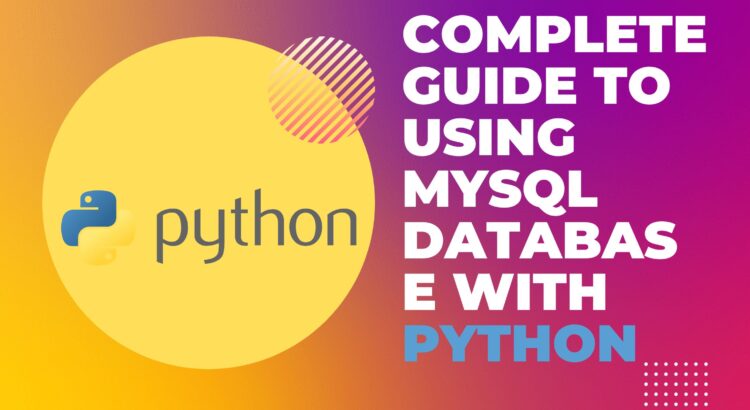In this article, We will explore how to work with MySQL databases using Python. Also, We’ll learn about the integration of MySQL with Python, allowing you to interact with databases and perform various operations.
Why Use MySQL with Python?
MySQL is a popular open-source relational database management system, widely used for storing and managing structured data. There are the following benefits of MySQL:
- Widely Supported: MySQL is supported by a large community and has extensive documentation.
- Scalability: MySQL allows to handle large datasets and high-traffic applications.
- Compatibility: MySQL works well with various operating systems, including Windows, macOS, and Linux.
- Data Integrity and Security: MySQL provides robust data integrity and security features.
In this tutorial, we will explore the following key topics:
- Setting Up MySQL in Python
- Connecting to MySQL Database with Python
- Creating Database Tables in MySQL
- Inserting Data into MySQL Tables
- Fetching Data from MySQL Tables
- Updating Data in MySQL Tables
- Deleting Data from MySQL Tables
- Effective Error Handling and Exception Handling in MySQL with Python
Setting Up MySQL with Python
We’ll install the necessary packages to connect MySQL with Python. Let’s install the following packages:
- Install MySQL: Download and install the MySQL Community Server from the official MySQL website (https://www.mysql.com) and install it into your system. If you already have a server installed, you can skip this step.
- Install MySQL Connector/Python: MySQL Connector/Python is a Python driver that allows Python programs to access MySQL databases. You can Install it by running the following pip command in your terminal:
pip install mysql-connector-python
Connecting to the MySQL Database
Let’s establish a connection to the MySQL database, We need to provide the necessary credentials such as the hostname, username, password, and database name. You can use following code to connect MySQL with python:
import mysql.connector
# Establish connection
cnx = mysql.connector.connect(
host="localhost",
user="username",
password="password",
database="database_name"
)
# Create a cursor to execute SQL queries
cursor = cnx.cursor()
# Perform database operations
# Close the cursor and connection
cursor.close()
cnx.close()Once the connection is established, we create a cursor object, which allows us to execute SQL queries and fetch results from the database.
Executing SQL Queries
We have established a connection to the MySQL database. Now, You can perform various operations, such as creating tables, inserting data, querying data, and updating records. Let’s explore some common operations using Python.
Creating a Table
To create a table, we use the CREATE TABLE statement. Here’s an example that creates a simple "users" table:
# SQL query to create a table create_table_query = """ CREATE TABLE users ( id INT PRIMARY KEY AUTO_INCREMENT, name VARCHAR(50), email VARCHAR(100) ) """ # Execute the query cursor.execute(create_table_query)
Inserting Data
To insert data into a table, we use the INSERT INTO statement. Here’s an example of inserting a new user:
# SQL query to insert data
insert_data_query = """
INSERT INTO users (name, email)
VALUES ('John Doe', '[email protected]')
"""
# Execute the query
cursor.execute(insert_data_query)
# Commit the changes
connection.commit()Fetching Data
To retrieve data from a table, we use the SELECT statement. Here’s an example of fetching all users:
# SQL query to fetch data
fetch_data_query = "SELECT * FROM users"
# Execute the query
cursor.execute(fetch_data_query)
# Fetch all rows
rows = cursor.fetchall()
# Print the results
for row in rows:
print(row)Updating Data
To update existing data in a table, we use the UPDATE statement. Here’s an example of updating a user’s email:
# SQL query to update data update_data_query = """ UPDATE users SET email = '[email protected]' WHERE id = 1 """ # Execute the query cursor.execute(update_data_query) # Commit the changes connection.commit()
Deleting Data
To delete data from a table, we use the DELETE statement. Here’s an example of deleting a user:
# SQL query to delete data delete_data_query = "DELETE FROM users WHERE id = 1" # Execute the query cursor.execute(delete_data_query) # Commit the changes connection.commit()
Error Handling and Exception Handling
The mysql-connector-python package provides an exception handling for database-related errors.
try:
# Execute a query
cursor.execute(query)
except mysql.connector.Error as err:
print("An error occurred:", err)
exceptions handling ensure that your program continues to run smoothly even when errors occur during database operations.You can also checkout other python tutorials:
- Python do while with Example
- How To Load Json file Using Python
- Python List Example And Methods
- Create Rest API Using Python Fastapi
Conclusion:
In this tutorial, we have covered the basics of integrating MySQL with Python. We learned how to establish a connection to a MySQL database, execute SQL queries, and handle errors effectively.
